Native Son: December 2013
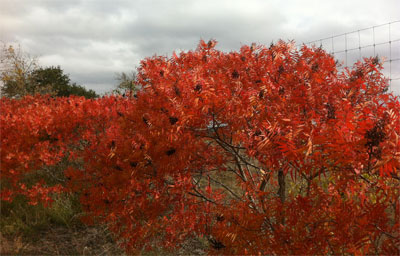
Orange sumac foliage along the road. All photos by Steven Chamblee.
Dreams, Bison, Jaguars, and Thanksgiving
by Steven Chamblee
I am always amazed — and delighted — by the way life serves up a bounty of experiences every time I come to the table. This harvest season has been especially abundant. I set the table with gratitude, baked up a road trip, carved out time to teach a few classes, kneaded my mind into thinking differently, dished up some memories with a class full of kids, and ladled on some adventure. What a spread!
I get up early to meet my buddy, Stephen Haydon, an English horticulturist who now resides in Fort Worth, at a big box parking lot in Weatherford so we can share a ride down to my speaking engagement in Goldthwaite. (Goldthwaite is a town about 90 miles west of Waco; small on population, but big on hospitality.) I get to the parking lot first, so I park my old truck and busy myself with organizing that pile of stuff on the dashboard. Not five minutes later, here comes Haydon, cruising up in a cheeky brown, low-to-the-ground, vintage 1995 Jaguar XJ6 four-door motorcar. He rolls down the power window, grins broadly, and says, “Four thousand pounds of British steel that purrs like a kitten and roars like a … well, you know.” A moment of dumbfounded silence passes before I utter, “You’re driving.”
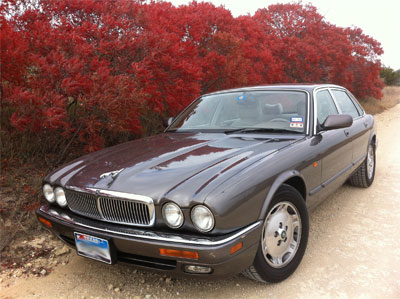
The Jag
We’re on the road in a flash, and forty seconds later I am threatening to throw that robot-voiced GPS out the window. Stephen quickly unplugs it, but the thing keeps on talking. I’m pulling out my pocketknife to disembowel the critter when Stephen finally finds the “off” switch, looks at me coolly, and says, “We can be civil about it.”
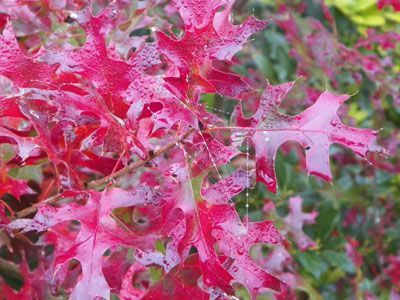
Screaming bright red oak leaves command your attention.
I wait for Stephen to get busy admiring the roadside fall color before quietly pulling out a cigar and putting it in my mouth. I clear my throat slightly to get his attention and say, “Got a light?”
There are a few visions burned into my memory forever, and that look on Stephen’s face is one of them. The rare combination of shock, offense, and sheer horror, together with that incredulous gasp was truly memorable. It was if you asked a woman if it was OK to spray paint her baby. Best laugh I’ve had all year, and it set the tone for a day full of brotherly antics.
Road trips are starting to take longer these days, because guys over 50 need to pee more often than in the old days. Fortunately, this leads to discussion of aging, which inevitably leads to dreams unlived and songs unsung, which leads to overcoming the roadblocks of never enough time and money. I bring us to a reality check: we’re driving down smooth roads in a Jaguar to a leisurely adventure. The truth is that on a global view, we live like kings. Sure, we both work hard and all, but we are blessed to be where we are. Then the good stuff begins: the list of things for which we are grateful. We have both reached an age of appreciation: for what we have, for what we don’t have, for memories good and bad, for dreams lived and unlived, for prayers answered and unanswered. The miles roll by like nothing, and all we remember is the beauty of life. Goldthwaite appears.
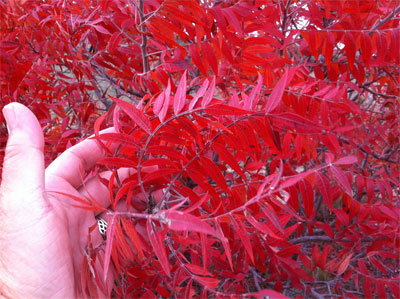
Crimson leaves bring drama to Goldthwaite.
The meeting room is filled with kind eyes, warm hearts, and a few chairs to rest them upon. Discussion ranges from large concrete pots on the square to the groundbreaking for a Goldthwaite Botanic Garden (yeah!) to the passing of an old friend. This last one hits me in the gut — the last time I spoke here, I was accompanied by Dennis Jones, a buddy of mine who passed away this year. I include a few photos of Dennis in my presentation, including the last photo I ever took of him, which, amazingly, includes Stephen Haydon.
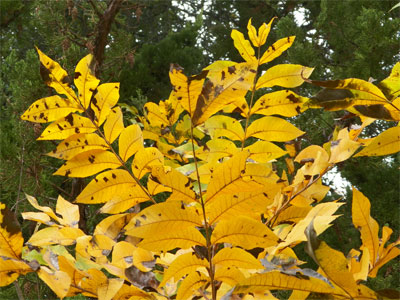
Golden yellow pecan leaves are a common sight around Goldthwaite.
The talk goes well and, predictably, these fine Southern ladies charmingly force-feed us platefuls of delicious homemade goodies. (OK, it doesn’t take much forcing!) My memory fades back to my childhood, when Grandmommie would cook for hours, sweetly say grace, then watch my brothers and me dive face-first into everything, only looking up when we finally realized, with guilty consciences, that we hadn’t expressed our appreciation. She would simply smile and say, “I love to see my boys eat.” Many years would pass before I would fully appreciate how her sweet, loving left hand and firm, guiding right hand worked together to help mold her grandchildren. Now I find myself in front of a small congregation of grandmothers, and I see this love and beauty in each and every one of them.
Twelve kind hugs and one sack full of goodies for the road, and we are on our way toward Hamilton. The fall color is simply spectacular this year: cottonwoods create bright yellow bands along the waterways, elms and pecans glow golden from the woodlands, oak and sumac paint the ridges and escarpments with rich oranges and brilliant reds. A fine line of sumacs brings us to a halt to feast on the incredible color.
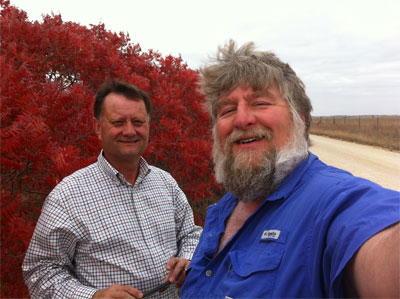
Stephen and Steven stop to check it out.
Prairie flameleaf sumac (Rhus lanceolata) is a widespread native plant that forms dome-shaped colonies in meadows, pastures, roadsides, and fence lines. I love this manner of proliferation. A seed dropped from a bird germinates and grows a single plant. From this single plant, underground stems called stolons form and encircle the plant, eventually growing into new plants themselves. This new “ring” of plants then forms stolons and the process repeats itself outward until the colony is about 150 feet wide. (For reasons unknown to me, these colonies don’t seem to grow much larger than that.) The end result is a shallowly sloped mound of sumac, the center one being the oldest and tallest, with each successive “ring” being a year or two younger and shorter than the previous one. When started on a fence line, these colonies are often mowed/grazed off on either side of the fence, leaving a long, thin “Mohawk haircut” of sumac.

A “Mohawk” of sumac graces the fence line.
I think of sumac as a harbinger of autumn. One of the first plants to color up its foliage for the fall, its leaves can range from yellow-orange to pure bright orange to crimson red to a dark burgundy. Adjacent colonies are often different hues, making for contrasting swatches across the landscape’s blanket of fall color.
Native sumac is more than tough and beautiful. It has high levels of tannins, making it valuable for the tanning industry. Even so, settlers continued to import sumac tannins from other countries rather than use the abundance of product that was right under their noses. (This doesn’t surprise me as much as it should, as mankind has been ignoring the obvious for centuries — native bison for meat production, native plants for landscaping, solar and wind energy, etc.) Ripe sumac fruits make a tart snack, and Native Americans mixed the dried red leaves with tobacco for ceremonial smoking. (I have tried the fruits … not bad … but have yet to wrap a few leaves around a cigar. I’ll let you know….)
So Steven and Stephen roll into Hamilton with meat on our minds. (Yes, I can see you ladies giggling at that self-deprecating sentence.) Naturally, we make a beeline for my favorite Carnivore Capitol of Texas, the Wenzel Lone Star Meat Company. Full-tilt flavor, no preservatives, no fillers, no fooling around. I grab a few shakers of Bite My Butt Rubb and toss them onto the counter next to our pile of pork, our batch of beef, and our bounty of bison. Toss a big ol’ chunk of cheese on there for good measure. Ring me up … I’m yours.
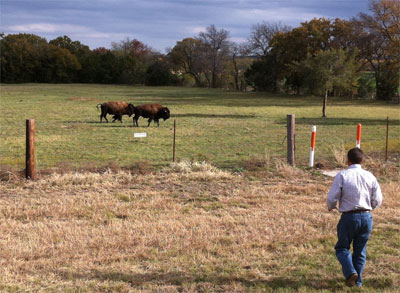
Bison back to normal.
Two miles out of town, the Jag comes to a screeching halt as we witness two bison cavorting in a pasture. Neither of us has ever seen them jostle, slam, and bang each other about while running full steam for a quarter mile or so. By the time I can get my camera out, they have stopped their antics and resumed that slow, dignified pace that we’re all used to seeing. Then it hits me … we 50-plus-year-old men are like bison … we still want to run around, kick up our heels, and raise a little ruckus once in a while, but we sure don’t want anyone knowing it. And heaven knows, we don’t want anyone taking a photo of it. So, we slow down and act all dignified in public … thinking no one’s the wiser. Shhh….
Five miles down the road, Stephen’s eyes are looking a little droopy, and I ask him if he’s all right. He says he usually has a nap about this time of day … would I drive for a while?
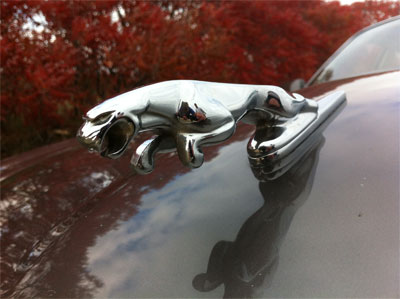
I love the way you can see our reflections in the chrome Jaguar.
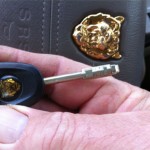
Not the only Key to Happiness, but not too shabby.
So the adventure wraps up with me driving a sweet ol’ Jaguar up Highway 281, cruising through the fabulous fall color while Stephen snoozes away. It’s truly a memorable moment, and I remind myself that all we ever really have in this life is moments, strung along the line of time like beads on a necklace. Some moments are sharp as glass; others smooth as polished stone. Some as colorful as coral; others dull as bone. I revel in this moment, for this one’s a pearl … a rare and precious pearl that I can fully appreciate. And for that, I am truly grateful.
Steven adds these notes:
Come celebrate the glory of autumn at Chandor Gardens! Go to www.chandorgardens.com for details. Just take I-20 west to exit 409, hang a right, go 2.1 miles and hang a left on Lee Avenue. Head straight 12 blocks and you’re driving in the gates. Call 817-361-1700 for more information.
I can always use another road trip! Let me know if you’d like me to come out and speak to your group sometime. I’m low-maintenance, flexible, and you know I like to go just about anywhere. No city too big; no town too small. Just send me an e-mail at stevenchamblee@yahoo.com and we’ll work something out.

